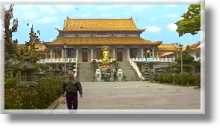

圓光寺 Yuan-Guang Buddhist Temple
 The Yuan-Guang Buddhist Temple was established in 1918 by Monk Miao-Guo. He became a monk when he was 19 years old and became so famous in the Buddhist circles that the Japanese Emperor even invited him to teach Buddhism to the royal family for many years. After he returned to Taiwan, he built Yuan-Guang Buddhist Temple and Fa-Yun Buddhist Temple (in Miao-Li) and established the first Buddhist school in Taiwan to educate teen-age Buddhists. The incumbent abbot of Yuan-Guan Buddhist Temple is the fourth abbot in the history of the temple, Monk Ru-Wu. The old temple has undergone major renovations and expansions during his term. In 1987, a graduate program was added to the original school which used to provide only high school and college education to young Buddhists.
The Yuan-Guang Buddhist Temple was established in 1918 by Monk Miao-Guo. He became a monk when he was 19 years old and became so famous in the Buddhist circles that the Japanese Emperor even invited him to teach Buddhism to the royal family for many years. After he returned to Taiwan, he built Yuan-Guang Buddhist Temple and Fa-Yun Buddhist Temple (in Miao-Li) and established the first Buddhist school in Taiwan to educate teen-age Buddhists. The incumbent abbot of Yuan-Guan Buddhist Temple is the fourth abbot in the history of the temple, Monk Ru-Wu. The old temple has undergone major renovations and expansions during his term. In 1987, a graduate program was added to the original school which used to provide only high school and college education to young Buddhists.
The architectural design of Yuan-Guan Buddhist Temple is well-known for its simplicity and solemnity. Entering the gate, you will immediately see the majestic laughing Buddha, better known as Mi-Le, which brings a feeling of joy to all its visitors. An exquisite garden and solemn Buddhist statues pave the way toward the steps leading up to the main temple. A white wall decorated with elegant green roof tiles surrounds the whole premise, making the huge Guan-In statue that stands right in front of the main temple look all the more solemn. The grand northern-style main building avoided the over-decoration of most Chinese temples; instead, it surrounds its Buddhas with is simple paintings depicting Buddhist legends. Behind the temple are classrooms for Buddhist education.
The temple cares about the living as well as the dead. That is why there is a mausoleum located in an adjacent compound, where people could bring the ashes of their deceased loved ones and leave them in the care of the temple.
Today, the temple perform multiple functions for the Buddhist community, including worship, education, culture, and charity. The temple itself has also become a favorite attraction and an important symbol of Buddhist culture in the Chung-Li region.
 The Yuan-Guang Buddhist Temple was established in 1918 by Monk Miao-Guo. He became a monk when he was 19 years old and became so famous in the Buddhist circles that the Japanese Emperor even invited him to teach Buddhism to the royal family for many years. After he returned to Taiwan, he built Yuan-Guang Buddhist Temple and Fa-Yun Buddhist Temple (in Miao-Li) and established the first Buddhist school in Taiwan to educate teen-age Buddhists. The incumbent abbot of Yuan-Guan Buddhist Temple is the fourth abbot in the history of the temple, Monk Ru-Wu. The old temple has undergone major renovations and expansions during his term. In 1987, a graduate program was added to the original school which used to provide only high school and college education to young Buddhists.
The Yuan-Guang Buddhist Temple was established in 1918 by Monk Miao-Guo. He became a monk when he was 19 years old and became so famous in the Buddhist circles that the Japanese Emperor even invited him to teach Buddhism to the royal family for many years. After he returned to Taiwan, he built Yuan-Guang Buddhist Temple and Fa-Yun Buddhist Temple (in Miao-Li) and established the first Buddhist school in Taiwan to educate teen-age Buddhists. The incumbent abbot of Yuan-Guan Buddhist Temple is the fourth abbot in the history of the temple, Monk Ru-Wu. The old temple has undergone major renovations and expansions during his term. In 1987, a graduate program was added to the original school which used to provide only high school and college education to young Buddhists.The architectural design of Yuan-Guan Buddhist Temple is well-known for its simplicity and solemnity. Entering the gate, you will immediately see the majestic laughing Buddha, better known as Mi-Le, which brings a feeling of joy to all its visitors. An exquisite garden and solemn Buddhist statues pave the way toward the steps leading up to the main temple. A white wall decorated with elegant green roof tiles surrounds the whole premise, making the huge Guan-In statue that stands right in front of the main temple look all the more solemn. The grand northern-style main building avoided the over-decoration of most Chinese temples; instead, it surrounds its Buddhas with is simple paintings depicting Buddhist legends. Behind the temple are classrooms for Buddhist education.
The temple cares about the living as well as the dead. That is why there is a mausoleum located in an adjacent compound, where people could bring the ashes of their deceased loved ones and leave them in the care of the temple.
Today, the temple perform multiple functions for the Buddhist community, including worship, education, culture, and charity. The temple itself has also become a favorite attraction and an important symbol of Buddhist culture in the Chung-Li region.
